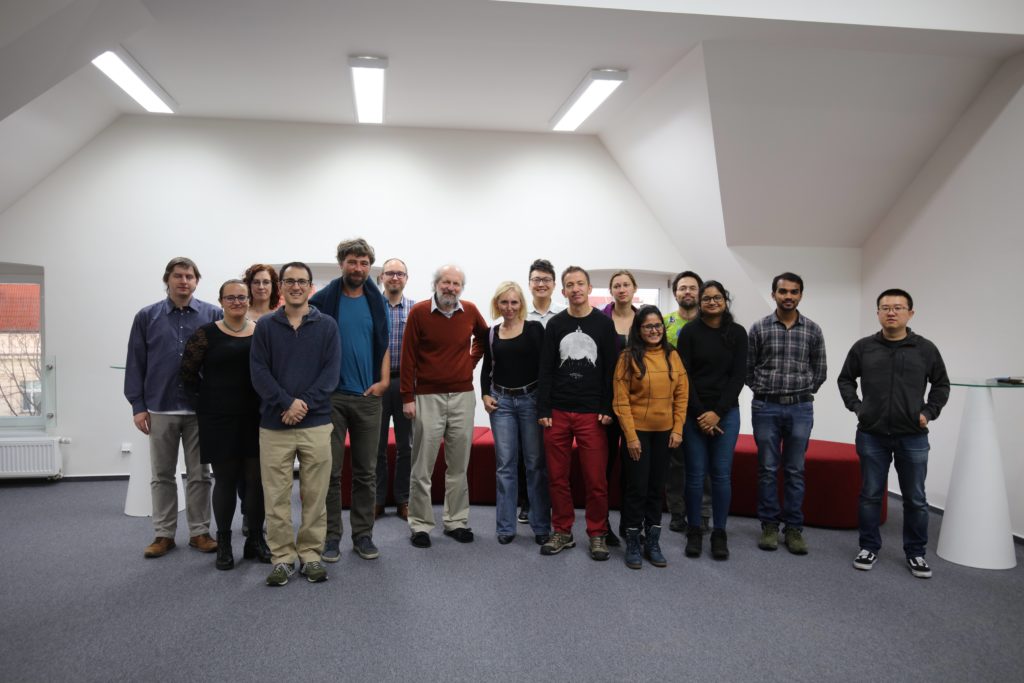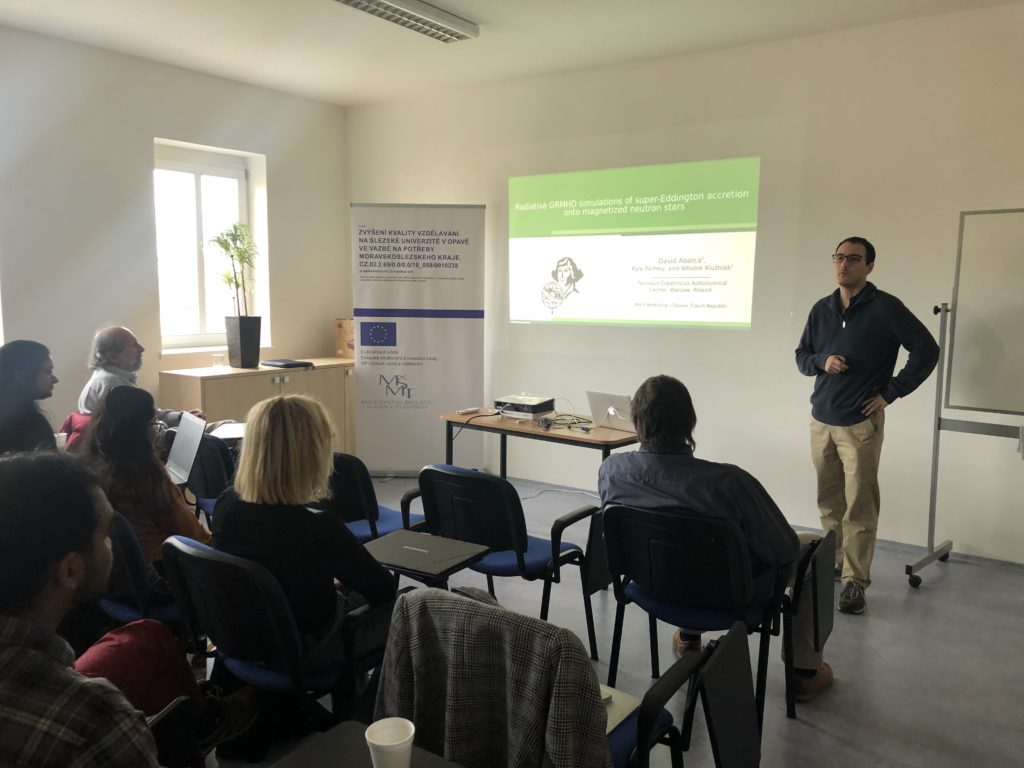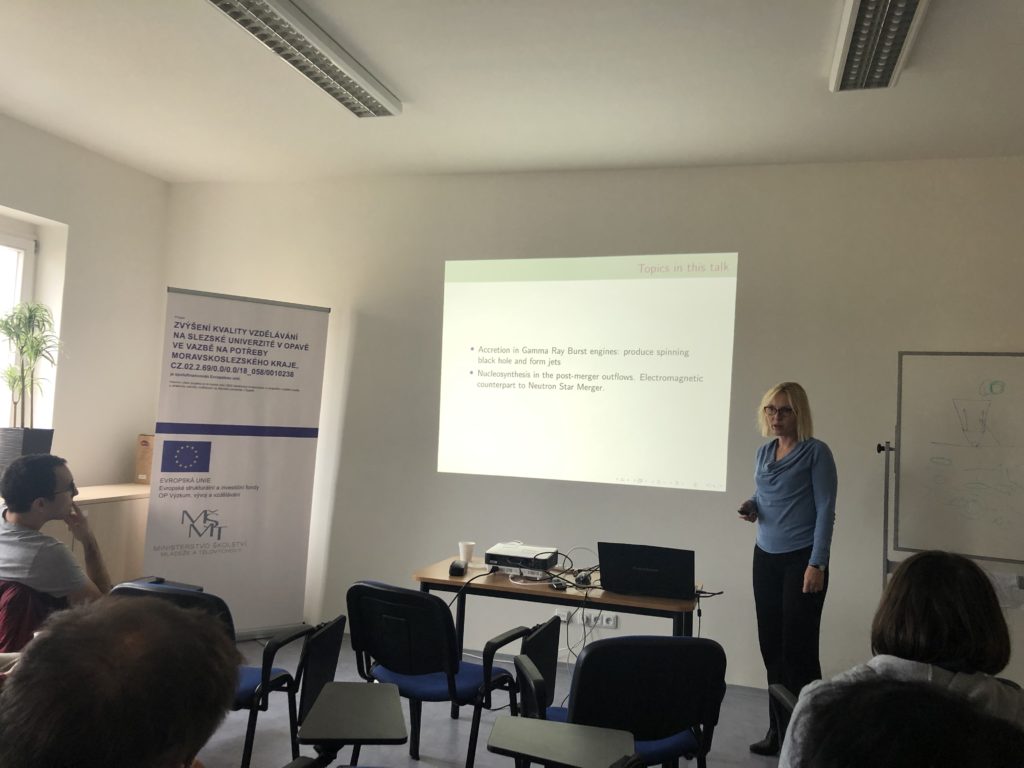4. – 6. 11. 2019
Bezručovo náměstí 13




Set of seminars about MHD, accretion disks simulations and related topics
Invited speakers
Tuesday, 5th November
Magnetically threaded accretion discs around millisecond X-ray pulsars in resistive MHD simulations
Włodek Kluźniak
CAMK, Warsaw, Poland
A resistive MHD simulation of an accretion disk and magnetosphere around a star endowed with a magnetic dipole will be presented (Cemeljić, Kluźniak, Parthasarathy submitted). A realistic model of magnetic linkage between a neutron star and its accretion disc is a prerequisite for understanding the spin history of millisecond and X-ray pulsars. To this end we aim to provide an analytic model in agreement with the MHD simulations. For the first time we write (a full set of) stationary asymptotic expansion equations of a thin magnetic accretion disk.
Backflow in thin accretion disk Ruchi MishraCAMK, Warsaw, Poland For some values of viscosity parameter, part of the accretion flow in the disk is not towards the star, but in the opposite direction. Such backflows, when obtained in numerical simulations, are usually discarded as nonphysical. However, there is analytical solution with backflow for thin disks. We study such thin disks by performing hydrodynamic simulations using the PLUTO code, to compare the numerical with analytical results. We confirm that for viscosity parameter smaller than some critical value, there is a backflow in the mid-plane of the disk. The distance to the starting point of backflow is increasing with viscosity as predicted. We extend this study to the cases with magnetic field.
The effect of magnetic field strength and mass accretion rate on theluminosity of ULX pulsars David AbarcaCAMK, Warsaw, Poland We report on 2D axisymmetric simulations of super-Eddington accretion onto magnetized neutron stars. We use the radiative general relativistic magnetohydrodynamic code Koral in which we have implemented a method which allows the code to handle the highly magnetized regions near the neutron star by using elements of force-free electrodynamics. The main application of our simulations is to ultra-luminous X-ray sources which have been shown to harbor neutron stars accreting above their Eddington limit. We perform a small parameter study to understand the effect that the magnetic field strength and accretion rate have on the structure of the accreting system as well as the observed luminosity as a function of the inclination angle.
Black hole magnetosphere and accretion tori Martin KološSilesian University in Opava, Czech Republic
Using general relativistic magnetohydrodynamics simulations we study evolution of antisymmetric accretion torus around black hole endowed with different initial magnetic field configurations. Preliminary results of two co/cotra-rotating tori numerical simulations will be also presented.
Mass and spin constraint on black holes associated with long GRB’s in Collapsar model Ishika PalitCFT, Warsaw, Poland Gamma ray bursts are highly energetic and brightest explosions that have been observed in EM spectrum. These can last from few seconds to few hours. The progenitors of long GRBs are believed to be massive stars exploding due to the collapse of their cores. Matter from the star around the core falls down towards the center forming a gaseous envelope and (for rapidly rotating stars) swirls into a highly density accretion disk. In my talk, I will present our results showing how much mass and spin a newly formed black hole should possess during collapsar to launch long GRB. In our model, We start with a newly formed black hole whose mass and spin are going to evolve depending on the rotation of the collapsing cloud. We set a critical angular momentum of the cloud at certain circular radii and we further study the growth of black hole in sub critical, critical and super critical regime. In addition to metric change effects on the evolution, mini disk formation has also been investigated and have been accounted for variability in accretion rate. Our results also testify that the massive BH detected by LIGO till date was never able to launch a powerful GRB because as per our results such massive BH should not have required high spin to support such event.
Light curve “hiccups” caused by accretion column switching stellarhemispheres Miljenko ČemeljićCAMK Warsaw, Poland Switching of the accretion column between the stellar hemispheres in the magnetosphere of a star can produce “hiccups” in the observed lightcurves. I performed two dimensional axisymmetric resistive and viscous magnetohydrodynamic simulations of star-disk magnetospheric interaction. The result is used to construct a three-dimensional model of a star with the ring-shaped hot spots from accretion columns infalling onto the stellar surface. A part of the ring from the hot-spots can be removed to obtain a non-axisymmetric model with arc-shaped hot spots. Such models can be used to explain irregular patterns in the light curves, and relate physical parameters in the simulations to the observed light curves.
Modeling short gamma ray bursts from binary neutron star mergers with general relativistic magnetohydrodynamics Agnieszka Janiuk
CFT PAS I will present the recent development of numerical tools for GR MHD modeling of the black hole accretion flows. The black hole appears as the result of a binary neutron star merger, and is surrounded by a remnant debris torus. The code named HARM_COOL is our implementation of the existing algorithm for a conservative GR MHD scheme. The newly added modules cover the neutino cooling and the nuclear equation of state for dense matter, as relevant for the physics of accretion flows in a gamma-ray burst (GRB) central engine environment. We also implement further post-processing with a nuclear reaction network, and reproduce the nucleosynthesis of heavy, neutron-rich isotopes. These elements are synthesized within the magnetically driven outflow from the remnant torus. These fast wind outflows (v/c 0.11−0.23) appear with a broad range of electron fraction Ye∼0.1−0.4. The total mass loss from the post-merger disk via unbound outflows is between 2% and 17% of the initial disk mass. The results are in agreement with the scenarios that explain blue and red kilonova components, detected in optical lightcurves after the gravitational wave event GW 170817.
Modelling AGNs and XRBs with Monk, a GR radiative transfer code Wenda Zhang (ASU AV ČR) Phenomenological modeling of AGNs and XRBs can produce results that can be directly compared with observations and is thus extremely useful in putting constraints on the properties of the black hole and accretion flow. Monk is a 3D radiative transfer code that takes into all general relativistic effects. In this talk, I will present some preliminary results calculated by Monk, where we modeled the spectral, polarization, and timing properties of both AGNs and XRBs.